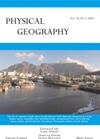阶地的形成和保护:圣卡塔琳娜岛和其他加利福尼亚海峡群岛
IF 1.4
4区 地球科学
Q4 ENVIRONMENTAL SCIENCES
引用次数: 0
摘要
圣卡塔利娜岛(Santa Catalina Island)上存在凸起的海岸梯田,但由于保存得非常糟糕,研究人员一个多世纪以来一直在争论它们是否存在。加利福尼亚海峡群岛基于激光雷达地形的形态测量学分析表明,卡塔利娜岛上梯田的表现不佳是由于以下两个因素的结合:(1)地质条件不如其他海峡群岛有利于梯田的形成;(2)卡塔利娜海岸边缘周围的山体滑坡易损性高,在梯田形态和沉积物到达该岛相对未被解剖的内部之前,它们就被抹去了。这两个因素似乎都与岛上主要岩石类型卡塔利娜片岩的机械特性有关。其他几个海峡群岛,如圣巴巴拉岛、圣克莱门特岛、阿纳卡帕岛和圣米格尔岛,其地形主要由阶地形态决定,这主要是由于这些岛屿面积小。在所有的大岛中,圣罗莎岛的梯田面积最大,这显然是由普遍存在的浅层沉积岩造成的。一般来说,从阶地保存的角度来看,亚水平沉积单元似乎代表了促进最初形成宽阶地台地和随后抵抗阶地侵蚀之间的最佳选择。本文章由计算机程序翻译,如有差异,请以英文原文为准。
Terrace formation and preservation: Santa Catalina Island and other California Channel Islands
ABSTRACT Uplifted coastal terraces are present on Santa Catalina Island, but so poorly preserved that researchers have debated for more than a century whether they even exist. Morphometric analyses of LIDAR-based topography on the California Channel Islands suggest that the poor expression of terraces on Catalina Island is due a combination of (1) geological conditions less conducive to terrace formation than on the other Channel Islands and (2) high landslide susceptibility around Catalina’s coastal margin that is erasing terrace morphology and deposits before they can reach the island's relatively un-dissected interior. Both of these factors seem to be related to the mechanical properties of the island’s predominant rock type, the Catalina Schist. Several of the other Channel Islands – such as Santa Barbara, San Clemente, Anacapa, and San Miguel Islands – have topography that is dominated by their terrace morphology, mostly by virtue of the small size of those islands. Of the large islands, Santa Rosa has the most extensive terraces, apparently driven by the prevalence of shallowly dipping sedimentary rock. Looking at terrace preservation generally, subhorizontal sedimentary units seem to represent an optimum between promoting the initial creation of wide terrace platforms and resistance to terrace erosion thereafter.
求助全文
通过发布文献求助,成功后即可免费获取论文全文。
去求助
来源期刊

Physical Geography
地学-地球科学综合
CiteScore
3.60
自引率
0.00%
发文量
18
审稿时长
6 months
期刊介绍:
Physical Geography disseminates significant research in the environmental sciences, including research that integrates environmental processes and human activities. It publishes original papers devoted to research in climatology, geomorphology, hydrology, biogeography, soil science, human-environment interactions, and research methods in physical geography, and welcomes original contributions on topics at the intersection of two or more of these categories.
 求助内容:
求助内容: 应助结果提醒方式:
应助结果提醒方式:


